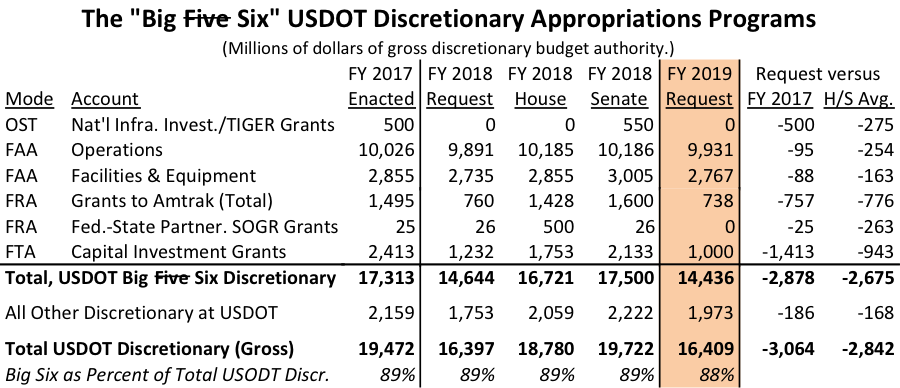February 15, 2018
On February 12, President Trump proposed a federal budget for fiscal year 2019 that would give the U.S. Department of Transportation $77.3 billion in gross new budgetary resources, which would be a reduction of $1.7 billion (2.2 percent) from the amount you would get from averaging the House and Senate versions of the non-yet-finished FY18 appropriations bill (excluding emergencies).
The USDOT budget documents do not reflect any of the proposed $200 billion in funding under the White House’s proposed infrastruture initiative, which is a multi-department endeavor that is being handled directly by the White House.
We have hyperlinks to all budget documents on Eno’s FY 2019 Transportation Budget and Appropriations Reference Page at www.enotrans.org/fy19 (bookmark it). A three-page PDF table of all USDOT accounts summary data, which was too big to fit in this online article, is here.
Highlights of the USDOT budget include:
- The budget request fully funds the FAST Act’s Highway Trust Fund obligation levels for 2019 ($56.6 billion).
- But, like last year’s budget, the new budget does not propose anything to fix the solvency of the Highway Trust Fund after it runs out of money in FY 2021.
- Like last year, the 2019 budget request proposes to kill the popular TIGER grant program and reduce the appropriation for new subway systems to the bare minimum necessary to fulfill projects already under construction (no new projects).
- Like last year, the 2019 budget proposes huge cuts in Amtrak subsidies ($776 million below the House-Senate FY18 average). However, instead of simply proposing to kill subsidies for long-distance routes, as they did last year, the new budget proposes that states pay one-half of the operating subsidy cost of long-distance routes going through their state.
- The budget does not propose any funding for the various railroad discretionary grant programs created by the FAST Act, which received a combined $90 million in the FY 2017 appropriations act.
- The budget proposes that railroads pay $50 million per year in new rail safety user fees to defray FRA overhead costs.
- The budget proposes significant cuts in several research programs, as high as 50 percent in aviation and railroad research accounts, for reasons that are not immediately clear.
- The Airport Improvement Program is kept at the same $3.350 billion as in recent years pending reauthorization.
- Unlike last year, the new budget does not propose to kill discretionary funding for the Essential Air Service subsidy program, but it does cut the appropriation down to $93 million and proposes some significant statutory changes in the program.
- The budget does not propose any rescissions of highway contract authority formula balances held by states (but some rescissions in allocated programs are proposed).
- The Maritime Administration gets a one-time $300 million appropriation (out of the new money made available by last week’s budget deal and being doled out by OMB, not shown in the regular Budget documents) to replace two training ships at the New York and Massachusetts state maritime academies.
- Contrary to earlier news reporting, the budget does not eliminate the special annual appropriation for the Washington DC Metro system, but it does reduce the “PRIIA” payment from $150 million to $120 million.
Discretionary spending. Budget rules divide spending into two general types: discretionary and mandatory. Last week’s budget deal was all about discretionary spending and gave the Appropriations Committees permission to spend $597 billion on non-defense discretionary programs in 2019. The Trump budget released today, the numbers for which were locked in weeks ago, proposed a total of $465 billion, which is $132 billion, or 22 percent, less than the number agreed to by the White House last week. As a result, Congress is even more likely than usual to ignore most cuts in discretionary programs proposed by the White House.
USDOT does not have a huge share of the government-wide discretionary pie, and of its share, five or six individual accounts take up about 90 percent of the DOT total each year. In the enacted 2017 law, these six accounts got $17.3 billion and the budget proposes to cut that to $14.4 billion by killing TIGER and New Starts and cutting Amtrak significantly. The rest of USDOT’s programs got $2.2 billion in discretionary money in 2017 and would get $2.0 billion in 2019 under this budget.

FAST Act. The FAST Act had two kinds of funding authorizations – contract authority from the Highway Trust Fund (mandatory), and authorizaitons for future appropriations (discretionary). That contract authority is in turn governed by obligation limitations in the annual appropriations bill, and the FY19 budget recommends the exact amount recommended by the FAST Act, to the dollar ($56.636 billion).
However, the FAST Act also authorized the Appropriations Committees to appropriate up to $4.938 billion in 2019 from the general fund of the Treasury for other accounts as part of the discretionary budget. The Administration is only requesting $2.077 billion

We have eight other articles in this week’s issue of ETW dealing with specific aspects of the FY19 budget request, which are linked below. Anything not covered in those articles is covered in the remainder of this article, below the links (just scroll down).
FY19 Budget Request: The Big Picture
FY19 Budget Request: Highway Trust Fund Promises Kept This Year, but No Plan for the Future
FY19 Budget Request: Mass Transit Again Faces New Start Cuts
FY19 FY19 Budget Request: FAA Funding Levels Maintained, EAS Changes Sought
FY19 Budget Request: Rail Programs Face Significant Cuts
FY19 Budget Request: Water Infrastructure Programs
FY19 Budget Request: TSA, Coast Guard, Transportation Security Grants
FY19 Budget Request: Transportation Taxes and User Fees
Office of the Secretary. The budget once again proposes zero funding for TIGER grants, which are by far the biggest component of the Office of the Secretary’s budget (the program got $500 million in 2017). Without TIGER, and not counting Essential Air Service (already discussed above), the total funding request for OST is $115.9 million, which is almost $20 million less than FY 2017.
The only real differences between 2017 and the 2018 request for these other programs are that the budget cuts the appropriation for the Research and Technology program from $13 million to $7 million and cuts funding for cybersecurity from $15 million to $10 million. (The annual appropriation is not the biggest funding component of Research and Technology – that also gets $26 million for the Bureau of Transportation Statistics and $77.5 million for the University Transportation Center program, both of which are funded through transfers of HTF contract authority outside the appropriations process.)
Safety. The budget request meets the exact obligation levels authorized in the FAST Act for all of the programs of the Federal Motor Carrier Safety Administration and for the grant and operating programs of the National Highway Traffic Safety Administration. The only real variable is the annual appropriation from the general fund for the vehicle safety activities of NHTSA.
The budget requests $152.4 million for these programs, which is $28 million less than in 2017 and $19 million less than the House-Senate FY 2018 average. Most of this reduction is a massive cut in the budget for vehicle safety enforcement.
| NHTSA’s Vehicle Safety Appropriation |
| Thousands of dollars. |
|
FY 2017 |
FY 2018 |
FY 2018 |
FY 2019 |
|
Enacted |
House |
Senate |
Request |
| Rulemaking |
23,510 |
?????? |
22,520 |
21,520 |
| Enforcement |
36,994 |
?????? |
21,042 |
17,016 |
| Research and Analysis |
41,600 |
?????? |
40,253 |
37,805 |
| Administrative Expenses |
77,971 |
?????? |
78,185 |
76,086 |
| Total, Vehicle Safety |
180,075 |
180,075 |
162,000 |
152,427 |
The enforcement budget got about $19 million on both 2015 and 2016, then Congress almost doubled it in 2017 in response to the Takata airbag debacle. Since the Senate’s 2018 bill also cut the line item from $37 million to $21 million, perhaps some sort of reduction is not unreasonable.
Funding in the budget request for the Pipeline and Hazardous Materials Safety Administration totals $254 million, which is $10 million less than the 2017 number and $16 million less than in the House-Senate FY 2018 average. The budget proposes $108 million for the National Transportation Safety Board.
Maritime. The regular budget documents from USDOT and OMB request a total of $396 million for the Maritime Administration, a sizeable decrease from the enacted 2017 level. The Maritime Security Program (the only USDOT account that is part of the defense budget) would drop from $300 million to $214 million, and the regular operational account would drop from $176 million to $152 million. The budget again proposes to defund those perennial Senate priorities, the Aid to Small Shipyards program and the Title XI Maritime Loan program.
But as part of the budget deal signed into law last Friday, a windfall of an extra $67.5 billion in non-defense spending for FY 2019 became allowable. This was too late for it to be incorporated in a budget that had already gone to press, and also, the White House doesn’t want to set expectations too high for the next budget deal for FY 2020-2021. So it is suggesting that the extra funding, where possible, go towards one-time capital expenditures that won’t create an expectation of being repeated in 2020.
Hence the Office of Management and Budget proposal to spend $300 million of the windfall to replace two outmoded training vessels used by the state maritime academies in New York and Massachusetts. This takes the total MARAD budget request from $396 million to $696 million.





